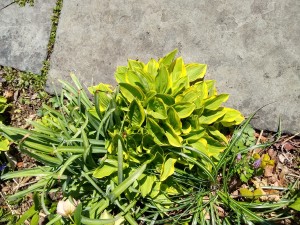 The other day I received a rather surprising email from the owner of one of my favorite online/mail order nurseries. I expected that it would be like many that I have gotten recently, using words like “in these troubling times”, “in this situation”, or “as we face an uncertain future.” I also expected that after those words, I would read an explanation of how the company was doing business and filling orders—or not–during the coronavirus crisis.
The other day I received a rather surprising email from the owner of one of my favorite online/mail order nurseries. I expected that it would be like many that I have gotten recently, using words like “in these troubling times”, “in this situation”, or “as we face an uncertain future.” I also expected that after those words, I would read an explanation of how the company was doing business and filling orders—or not–during the coronavirus crisis.
To my surprise, the owner wrote about being deluged with a very large number of orders and working hard within the framework of shelter in place restrictions to get all the plants packed and shipped to customers. He assured us all that the plants would arrive, but might land on the doorstep a bit later than originally expected. The email concluded with a “thank you” for customer loyalty and support.
My spirits soared.
That email was proof that a record number of people are turning to whatever “garden” is available—in the yard; on the balcony, terrace or porch; in window boxes or containers—and gardening to raise spirits, not to mention flowers and edible crops. With constant reminders of death looming all around us, we persist in seeking life wherever we can.
And that life has never been more vibrant. The long cool spring in my part of the world has kept the daffodils, hyacinths and other spring bloomers viable and beautiful for much longer than normal. On the other hand, I have been loath to sow seeds outdoors until the night temperatures notch up to around 50 degrees Fahrenheit. I will wait for another week or so.
Garden work allows outdoor time without worry about the epidemic or the state of the world. And there are so many chores to be done. Right now, as the early daffodils fade, it is time to think about dividing well established, healthy clumps. Dividing at the end of the blooming period allows you the luxury of installing divisions while you can still see the empty spaces in the spring planting scheme.
The same is true of hostas, which are springing from the soil and beginning to unfurl their leaves. Dividing those surging hostas now is a lot easier than waiting until they are fully grown and leafed-out. In both cases, don’t let fear get the better of you. Dig all the way around the clump, and include an outer margin of about two inches of soil. Dig down carefully to a depth of at least eight inches, possibly more for daffodils. Lift out the entire clump.
For daffodils, pull the clump apart with your hands, being careful not to damage the bulbs. Make one or two divisions depending on the size of the original clump. Replant one division in the original planting hole and install the others elsewhere.
Hostas have tough roots, so you may need a sharp trowel or garden knife to get them apart. Saw right through the roots, making sure that each division has plenty of root material attached. Replant the divisions and remember to water well.
A rainy spring is the gardener’s friend, because the loosened soil gives up those established clumps of daffodils and hostas quite easily. The same is true of weeds.
My garden is plagued with varmints, including groundhogs, rabbits, squirrels and entire herds of deer. I have skunks too, but with the exception of occasional shallow digging in garden beds they don’t seem to interfere with horticulture. No matter what varmints co-habit with you, now is the time to start deterrence. I have begun spraying all purpose critter repellent on all the vulnerable plants. The silver lining in the dark cloud of varmint invasion is that every spraying foray requires a full tour of the garden, which is especially good for the soul.
Online and catalog vendors are shipping plants now, so if there is something that you want, order it. The plants will most likely arrive before the shelter in place orders expire, so you might be able to use necessary planting as an excuse to get some respite from housework, tasks related to your job and/or homeschooling your children.
When horizons appear finite, gardens are a good reminder of the infinite possibilities inherent in growing things. I look at the leaves of the columbines that will be blooming in a month’s time and wonder what color the flowers will be. Most of mine are self-sown offspring of established plants, so surprises abound every spring. The same is true of the Spanish bluebells or Hyacinthoides hispanica. The majority of mine are pink, but some plants produce blue or white ones. You never know when those outliers will present themselves.
Stress is everywhere right now, popping up even more regularly than chickweed. Digging in the soft spring earth is a good remedy for both.
